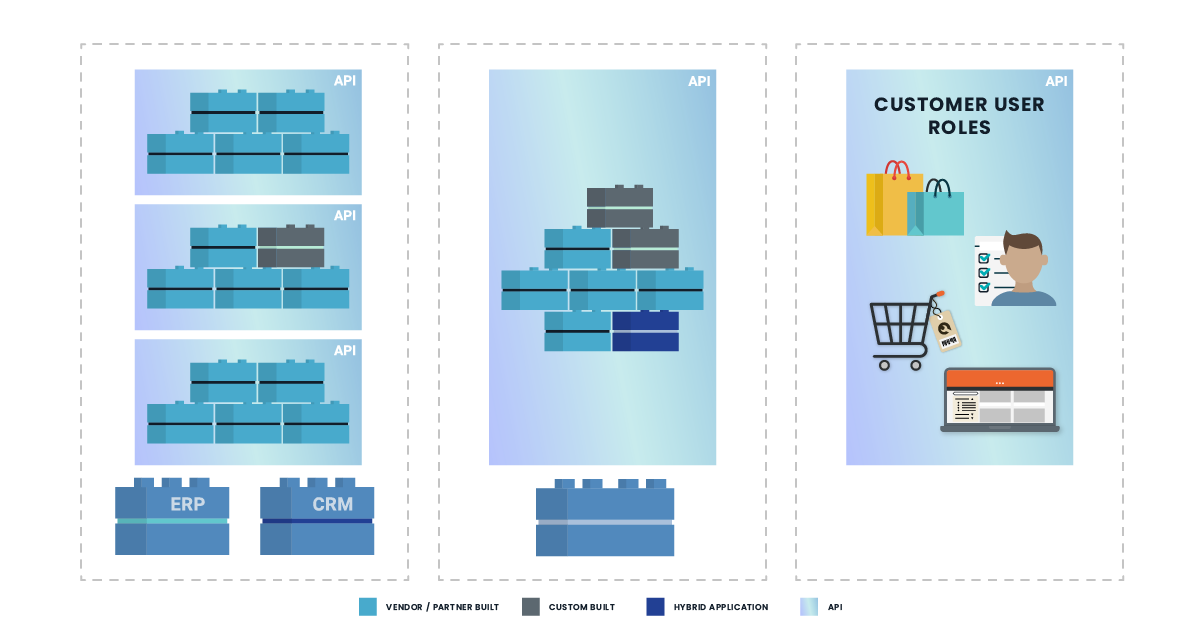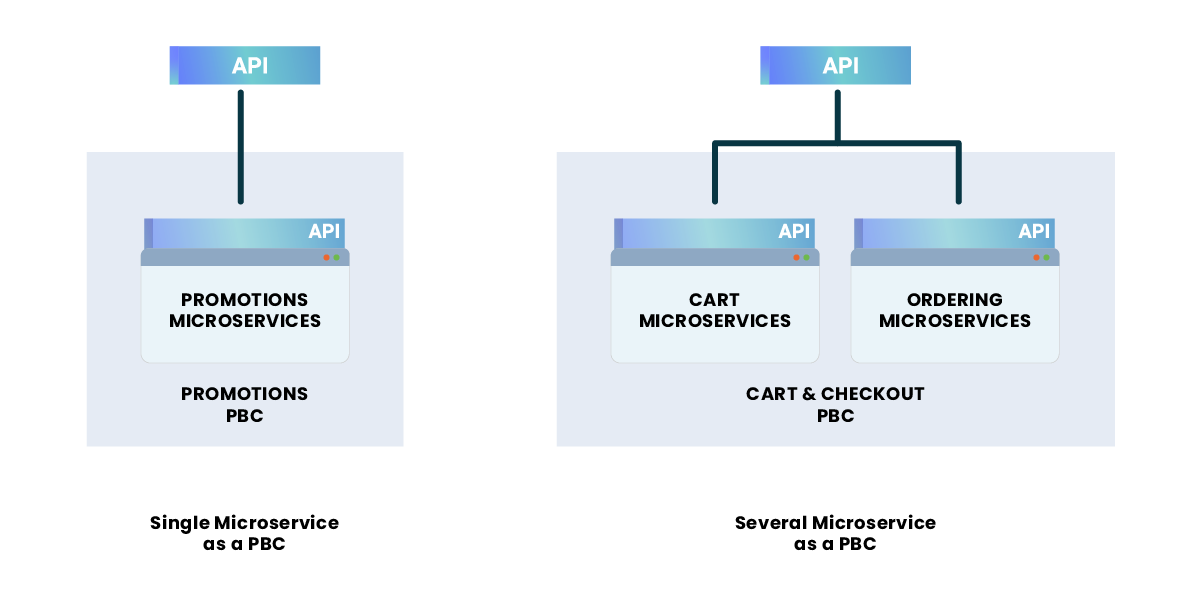Composable Commerce, The Sequel to Headless Ecommerce
The Headless Ecommerce Interlude
“Headless ecommerce is APIs,” to paraphrase Joe Ciciman, a leading Forrester Ecommerce Analyst. Headless ecommerce has gotten the B2B ecommerce industry to where it’s going.
Gone are the days of monolithic platforms, supposedly. Remnants can still be found in outdated platforms claiming to be headless, but are really monolithic platforms wrapped in APIs to check boxes in B2B ecommerce RFPs. Some may call this “ Headless Marketecture.”
Jump ahead:
- What is an API-first Ecommerce Platform?
- What is Composable Commerce?
- Reasons for Implementing Composable Commerce
- Composable Commerce Benefits
- Demands of Composable Commerce
- What are Packaged Business Capabilities (PBCs)?
- What are the differences between Microservices and PBCs?
- What is the MACH architecture?
- In the End Composable Commerce Wins
What is Headless Ecommerce?
Headless ecommerce in execution is an ecommerce platform that separates the data layer and logic layer or core from the presentation layer via APIs.
The decoupled nature of a headless ecommerce platform enables constant optimization of the customer experience, allowing for the commerce engine to be extended to limitless endpoints for customer interaction.
What is an API-First Ecommerce Platform?
An API-first ecommerce platform has all componentry exposed via APIs, such an ecommerce platform can be utilized in a composable approach to join customer experience components together.
What is the Final Evolution of B2B Ecommerce? Composable Commerce.
What is Composable Commerce?
Composable commerce is an application approach of combining best-of-breed commerce components to achieve a business’s desired customer experiences.
The three principles of composable commerce are:
- Centricity, specifically business centricity. Enabling business users to optimize digital strategy, eliminating or drastically reducing reliance on IT and development resources to deliver innovation.
- Modularity. The facilitation of the plug-and-play application allows for great agility in delivery, reduced time to market and improved customer experiences.
- Openness. Businesses can avoid vendor lock-in while composing best-of-breed solutions using application accelerators, pre-composed solutions, third-party applications and best practices.
Gartner describes the composable commerce approach as using packaged business capabilities (PBC) to move toward future-proof digital commerce experiences.
“By 2023, Gartner predicts that organizations that have adopted a composable approach will outpace competition by 80% in the speed of new feature implementation.”
An example of a composable commerce execution would include a variety of business services meeting customer and business needs. An example of composable commerce could be structured in this way: Avalara for tax; ShipperHQ for fulfillment; Znode for commerce, content and search services; Salesforce CRM for customer data, Cloudinary for digital asset management; and CardConnect for a payment gateway, to name but a few.
Reasons for Implementing Composable Commerce
When business and technology leaders are contemplating the evolution of technology stacks, customer experiences (CX) and total-cost-of-ownership (TCO) of existing technology investments opportunities typically align around sustainability.
Legacy commerce tech stacks cannot scale. Whether an entirely closed system or single/limited vendor system, tech stacks that cannot utilize best-of-breed applications will not be able to scale as market demands change.
Legacy commerce tech stacks depend excessively on IT and development resources. Enable business users to make the needed technology component selections and provide the agility to personalize user experiences.
Legacy tech stacks cannot align to desired CX or testing demands. Regardless of the IT dependency, legacy commerce technology stacks offered no or limited extensibility to fulfill modern buyer journey requirements.
End ecommerce replatforming once and for all. Never having to replace a business system, like an ecommerce platform, makes total cost of ownership a no-brainer. The composable architecture allows the needed components to be added and those unneeded to be removed.
Composable Commerce Benefits
- Plug-and-play application structure provides faster speed to market and agility to implement and scale.
- No limitations to customer experience platforms (Ecommerce website, progressive web applications, EDI, connected vending, etc.).
- The narrowing of technical discipline to API integration focus rather than multiple code bases.
- Focus is placed on the customer experience rather than business system limitations, empowering business users and reducing traditional IT department dependencies.
Demands of Composable Commerce
- Advanced organizational digital maturity.
An organization does not simply dive into the sea that is composable commerce. Wading in is much more manageable. Consideration needs to be given to the cross-functional collaboration among IT and business teams to execute the customer commerce experiences.
2. The management of multiple technology vendors.
Gone is the single vendor relationship. To provide the best-in-class experience to customers, best-of-breed solutions are needed. The management of numerous vendor relationships and SLAs is a consideration that must be made when pursuing a composable commerce approach.
3. A head is still required.
A completely headless experience requires businesses to craft an interface on top of other commerce components. Because there are independent databases syncing and nominating, sources of truth can be difficult to manage. Discover Znode’s “Headless with a Head” solution.
What are Packaged Business Capabilities (PBCs)?
A packaged business capability is a feature or capability of the composed experience fulfilled by a specific application and is typically a third-party software component. For example, a PBC could be a tax calculator, a business intelligence tool, or even a business user providing a function as a service (FaaS).

What are the Differences Between Microservices and PBCs?
Microservices are individual functions an application provides in a feature set or PBC. Packaged Business Capabilities are an aggregated set of microservices.

What is the MACH architecture?
Znode’s MACH architecture (Microservices, API-First, Cloud-based, and Headless) sets the cornerstones of composable ecommerce.
- Microservices - Microservice-based architecture enables the composability of PBCs. Monolithic platforms are too closed and implementations cannot be deployed independently.
- API-first - API-first ecommerce platform has all componentry exposed via APIs, such an ecommerce platform can be utilized in a composable approach to join customer experience components together.
- Cloud-based - Leveraging full capabilities of the cloud ensures scalability and flexibility across the composed experience. It also makes it easy to take advantage of each part of the application as needed on-demand, and allows you to avoid upgrades.
- Headless - The separation of the data layer and logic layer or core from the presentation layer via APIs provides an improvement of the customer interface, allowing application extensibility to unlimited endpoints.
In the End Composable Commerce Wins
As Gartner has stated, the future of competition is based on a business’s ability to compose a better experience than the competition. The reduction in resource dependencies and flexibility of the composable commerce approach provides a simpler business adoption.



